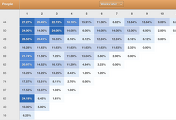최근 인상적인 광고는 '결국 사진, 결국 캐논'이라는 광고이다. DSLR이니, 미러리스니하는 복잡한 기능이나 용어보다는 사진을 보고 카메라를 결정하라는 의미일 것이다. 마찬가지로 사업계획서(Business Plan)는 계획서(Plan) 보다는 결국 사업(Business)이 중요하다. 사업계획서 작성에 대한 일반적인 내용과 Design Thinking Process를 이용해서 사업 아이템을 구체화하는 방법에 대해 정리했다.

1. 사업계획서 작성 시작하기
사업계획서 작성은 벤처캐피탈(VC)에서 제시하는 목차를 참고하면 좋다. Sequoia Capital의 목차가 거의 기본이 되는 것 같고, 국내 VC들이 제시한 목차도 참고할만 하다. 재밌는 점은 우리 제품은 이러이러합니다라는 접근 보다는 고객과 시장에는 이러이러한 Pain Point가 있다는 접근을 하고 있다. 즉, What 보다는 Why에 집중해서 사업계획서를 작성하도록 유도하고 있다.
(1) https://www.sequoiacap.com/grove/posts/6bzx/writing-a-business-plan
(2) http://www.jimmyrim.com/66
(3) http://blog.softbank.co.kr/?p=6040
(4) http://www.slideshare.net/MatthewLee/business-plan-51334117
정답은 없지만, 직접 작성을 해보니 (1)과 (2)가 가장 효과적으로 사업을 전달하는 방식으로 느껴졌다. (3)의 방식대로 작성을 해보려 했으나, 뭔가 정리가 안되고 산만한 느낌이 들어 중간에 포기했다.
(1)과 (2)를 참고한 사업계획서 목차는 다음과 같다. (위의 1~4번까지 링크의 내용을 반드시 숙지하자)
1. Executive Summary
2. Company Purpose (생략 가능)
- 회사/비즈니스에 대해 한 문장으로 설명하기
※ Pitch 방법
http://blog.naver.com/justalive/220173105597
3. Problem (Customer Needs)
- 고객(또는 고객의 고객)의 Pain Point
- 현재 시점에서 고객이 해당 이슈를 어떻게 해결하는지
4. Solution (Product or Service)
- 고객의 더 나은 삶을 위한 회사의 value proposition
- 회사의 제품이 어디에 위치하는지 positioning
- 필요하면 prototype 제시
5. Market Size
- Total Addressable Market
- Serviceable Addressable Market
- Serviceable Obtainable Market
※ 참고
- 시장 규모 추정
http://verticalplatform.kr/archives/4400
- TAM-SAM-SOM
http://verticalplatform.kr/archives/4855
6. Competition
- 경쟁자 리스트
- competitive advantage (우리의 강점)
7. Financial Projection
- P&L, B/S, C/F 등
- Cap table, Deal 등
※ Cap table은 투자의 각 round에 따라 창업자와 투자자의 지분의 변동과 희석을 보여주는 table이다.
- Cap table
http://venturehacks.com/articles/cap-table
- Cap table excel sample
http://venturehacks.com/friends
8. Why Funding (Use of Proceedings)
- 투자금은 얼마나, 왜 필요한가, 돈을 받아서 어디에 쓸 것인가
9. Team
- 창업자, 경영진
10. Appendix
- 앞에서 못한 말들을 모두 정리하자
Airbnb의 사례를 보면, 사업계획서를 어떻게 심플하게 작성했는지 알 수 있다.
그런데... 위의 목차대로 작성하면 Airbnb와 같은 매력적인 사업계획서가 만들어질 것인가?
2. 결국 사업, 사업아이템 구체화하기
결국, 사업계획서 작성의 핵심은 계획서가 아니라 사업이다. 사업아이템이 얼마나 매력적인지에 따라 사업의 성패가 달려있는 것이다.
초기 Ideation 단계에서는 팀원들과 모여서 브레인스토밍을 할 것이다. 브레인스토밍이 말은 좋지만, 막상 해보면 결과가 시원치않다. 좀더 체계적인 방식으로 접근하기 위해서 IDEO에서 개발한 Design Thinking 방법을 사용할 수 있다. Design Thinking은 창조적 능력의 핵심을 끌어내는 기법으로, 신제품 및 신사업 개발에 유용한 프로세스라고 한다.
(1) Design Thinking Process
원래 Design Thinking 프로세스는 Hear->Create->Deliver라고 한다.
Source: 감성능력의 80%는 시각, 동아비즈니스리뷰, 2012-08, No.111
그러나 개인적으로는 아래의 프로세스가 좀더 직관적이고 interation이 명확하게 표시되어 있어서 자주 애용한다.
Source: 처음엔 설마, 하지만 4일 만에 혁신제품 쏟아졌다, 동아비즈니스리뷰, 2012-08, No.111
(2) 기회
이 부분이 가장 어려운 부분이다. 사업계획서의 Problem, Customer Pain Point에 해당하는 부분이며, 전체 사업의 방향성을 잡는 부분이다. 답은 없으나, 뉴스와 리서치 자료를 보면서 탐색하거나, 개인적인 경험, 불편사항으로 접근하는 방법 밖에는 없다.
만약 대기업에서 기회 탐색을 한다면, 아래의 5가지 관점에서 탐색이 가능하다.
- 메가트렌드 관점: 기업 환경, 가치 창출, 기회와 리스크
- 고객 관점: 고객의 행태 및 Needs 분석, MOT(Moment of Truth) 분석
- 외부 환경 관점: Industry Analysis, Value Chain analysis
- 경쟁자 관점: Value proposition
- 내부 역량 관점: 핵심사업, 인접사업
다만, 너무 Deep dive해서 기회를 탐색하는데 엄청난 시간을 쓸 필요는 없다고 본다. 특히 스타트업처럼 lean, growth hacking해야 하는 영역에서는 좀더 감각적으로 접근하는 것이 좋다고 생각된다.
(3) 고객인사이트
고객 인사이트와 고객의 문제점/Paint Point 파악을 위해서 2가지 방법이 있다.
1) 속성 매칭을 통한 가상고객 도출
가상고객(페르소나)를 도출해서 니즈와 문제점, 솔루션을 찾는 것은 사업 아이템을 구체화하는데 많은 도움이 된다. 가상고객은 서울에 사는 30대 여성 등등으로 도출하게 되는데, 억지로 도출하기 보다는 속성들을 나열해서 매칭하는 방법이 있다.
젊은 시절의 소프트뱅크 손정의 회장은 300개의 단어카드를 만들어서 그중 3개를 뽑아서 사업아이템을 만들었다고 한다. 이를 참고해서 속성 매칭을 하면 된다.
예를 들어, 속성에는 국적(한국, 미국 등), 성별(남, 여), 연령(10대, 20대 등) 등이 있고, 속성 값들을 매칭해서 가상고객을 뽑아낸다. 가상고객1은 한국-남-20대 등의 고객을 지칭하는 식으로 하면 된다.
2) Jobs-to-be-done
가상고객을 도출하고, 이들의 paint point와 솔루션 탐색을 위해서 jobs-to-be-done 방식을 사용할 수 있다. Jobs-to-be-done은 사람들은 어떤 job에 대한 니즈를 야기하는 상황에 처할때, 그들은 job을 해결하기 위한 상품이나 서비스를 고용한다는 간단한 컨셉이다 (People encounter situations that drive the need for a job. They hire a product or service to get the job done.)
위에서 도출한 가상고객에 대해 아래와 같이 situation, motivation, expected outcome에 대해 도출하면 된다.
Source: http://www.slideshare.net/ClementGenin/jobstobedone
(4) 솔루션
고객의 니즈와 문제를 해결하기 위한 product concept을 정의한다. 다음의 내용으로 구성될 수 있다. 1장 정도로 요약해서 정리한다.
- 정의
- Target 고객
- 목표
- Value Proposition
- Service
주의할 점은 Target 고객 부분이다. 제품/서비스의 사용자(user)인지 사용도 하면서 돈도 지불하는 고객(customer)인지 구분이 필요하다. 예를 들어, 유아용품의 경우, 사용자는 아동이지만, 고객은 부모들이다.
가능하면 비즈니스 모델에 대한 고민이 필요하다. 비즈니스 모델은 아래 기사 참고하도록 한다.
(5) Lean하고 Quick하게, 반복반복
사업 아이템 도출 프로세스는 너무 많은 시간이 소요되면 안된다. 재빠르게 반복하면서 구체화를 하도록 하자.
3. 사업계획서 검토하기
Harvard Business Review의 'How to write a great business plan' (July-August 1997) 아티클을 보면, 훌륭한 사업은 다음의 특징을 가져야 한다고 한다.
"훌륭한 사업은 파악하기 쉬우나 따라하기는 어렵다는 특성을 갖는다. 위에서부터 아래까지 경험있고 열정적인 경영진이 있어야 한다. 경영진 멤버는 그들이 추구하는 기회에 직접적인 관련이 있는 기술과 경험이 있어야 한다. 이상적으로는, 그들은 과거에 성공적으로 함께 일한 경험이 있으면 좋다. 기회(opportunity)는 매력적이고, 지속가능한 비즈니스 모델을 갖고 있어야 한다. 그래야 경쟁 우위를 만들고, 그것을 방어할 수 있다. 비즈니스의 크기와 범위를 확장하기 위해 많은 옵션이 있고, 이러한 옵션은 회사와 팀에 unique해야 한다. 가치(value)는 비즈니스로부터 다양한 방법(매출 증대 또는 매각 등)으로 끌어낼 수 있다. 규제 및 거시경제 환경(context)은 비즈니스에 호의적이어야 한다. 리스크는 모두가 이해하고 있고, 경영진은 어려운 사건 발생시 이를 경감(mitigate)할 수 있는 방안을 고민해야 한다."
결론적으로 4가지 관점에서 사업계획서를 검토해야 한다. 4가지 관점은 1) People, 2) Opportunity, 3) Context, 4) Risk and Reward이다. 사업계획서 작성 후, 4가지 관점별 질문을 하도록 하자. 사업계획서에 해당 내용이 들어가지 않더라도, 향후 사업을 위해서 꼭 필요한 질문임을 명심하자.
(1) People
Fourteen "Personal" questions every business plan should answer
- Where are the founders from?
- Where have they been educated?
- Where have they worked - and for whom?
- What have they accomplished - professionally and personally - in the past?
- What is their reputation within the business community?
- What experience do they have that is directly relevant to the opportunity they are pursuing?
- What skills, abilities, and knowledge do they have?
- How realistic are they about the venture's chances for success and the tribulations it will face?
- Who else needs to be on the team?
- Are they prepared to recruit high-quality people?
- How will they respond to adversity?
- Do they have the mettle to make the inevitable hard choices that have to be made?
- How committed are they to this venture?
- What are their motivations?
(2) Opportunity
1) A good business plan begin by focusing on two questions
- Is the total market for the venture's product or service large, rapidly growing, or both?
- Is the industry now, or can it become, structurally attractive?
2) Nine questions about the business every business plan should answer
- Who is the new venture's customer?
- How does the customer make decisions about buying this product or service?
- To what degree is the product or service a compelling purchase for the customer?
- How will the product or service be priced?
- How will the venture reach all the identified customer segments?
- How much does it cost (in time and resources) to acquire a customer?
- How much does it cost to produce and deliver the product or service?
- How much does it cost to support a customer?
- How easy is it to retain a customer?
3) Questions about the cashflow implications
- When does the business have to buy resources, such as supplies, raw materials, and people?
- When does the business have to pay for them?
- How long does it take to acquire a customer?
- How long before the customer sends the business a check?
- How much capital equipment is required to support a dollar of sales?
4) Questions about the competition
- Who are the new venture's current competitors?
- What resources do they control? What are their strengths and weaknesses?
- How will they respond to the new venture's decision to enter the business?
- How can the new venture respond to its competitor's response?
- Who else might be able to observe and exploit the same opportunity?
- Are there ways to co-opt potential or actual competitors by forming alliances?
(3) Context
- 창업자는 자신들을 둘러싸고 있는 환경(규제, 거시경제)에 대해서 알아야 함
- 환경 변화 시, 자신들의 사업에 어떤 영향을 미칠지 예측해야 함
- 환경 변화를 긍정적으로 변화시킬 방안이 있는가
(4) Risk and Reward
- People, Opportunity, Context의 변화에 어떻게 대응할 것인가
- What happens if one of the new venture's leaders leave?
- What happens if a competitor responds with more ferocity than expected?
- Can the company be taken public at some point in the future?
- How will the investor eventually get money out of the business, assuming it is successful, even if only marginally so?
Source: How to Write a Great Business Plan, Harvard Business Review, July-August 1997
참고자료
http://verticalplatform.kr/archives/4400
http://verticalplatform.kr/archives/4518
http://verticalplatform.kr/archives/4622
http://verticalplatform.kr/archives/4855
경영컨설턴트이자 국제공인관리회계사인 안종식입니다. 주로 비즈니스 트렌드, 원가/관리회계, 스타트업, 커머스 그리고 중국에 대한 주제로 글을 쓰고 있습니다. 현재는 딜로이트에서 컨설팅 업무를 담당하고 있습니다.
blog: http://aliahn.tistory.com
mail: jongsikahn.cma[at]gmail.com
(모든 글은 제가 직접 작성했습니다. 제 허락 없이 무단으로 재배포할 수 없습니다.)
'스타트업 이야기' 카테고리의 다른 글
| D.CAMP Office Hours with 딜로이트 스타트업 자문그룹 (0) | 2017.12.04 |
|---|---|
| 스타트업에게 필요한 모든 것, 전략적 사고 (0) | 2017.09.10 |
| 16 More Startup Metrics - TAM, Cohort Analysis, Active Users 중심으로 (0) | 2017.01.15 |
| 데이터로 알아보는 유니콘 스타트업 (0) | 2016.03.27 |
| 스타트업의 health check 지표 - 16 Startup Metrics (2) | 2015.11.13 |







댓글